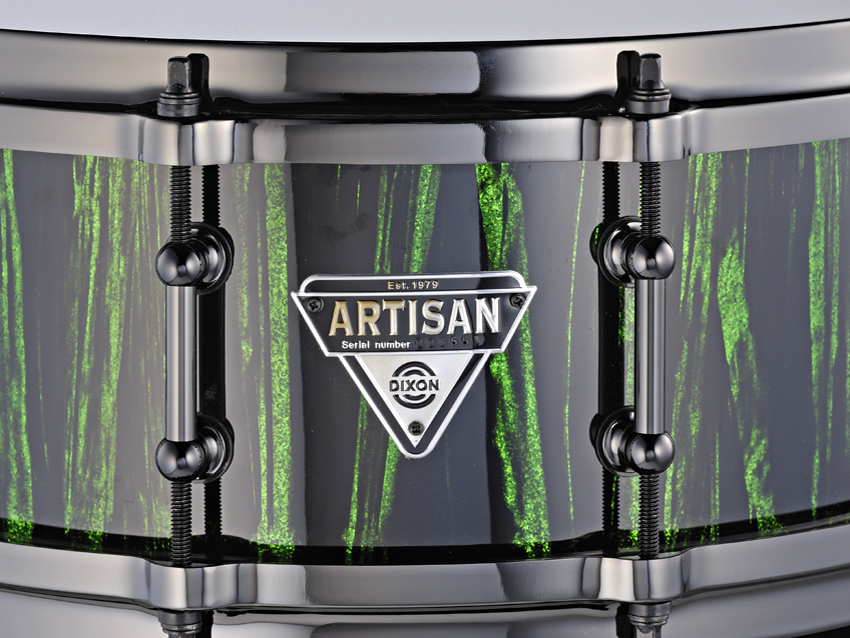MusicRadar Verdict
Considering Dixon's perceived low-end profile, this snare seems a little pricey. However, it's a capable drum that, considering its unforgiving shell composition, has enough finesse to handle the delicate dynamics of buzz rolls and subtle ghost notes. Drummers will love the open sound - sound engineers probably won't! This model may never become a 'classic' per se, but it could prove to be a good workhorse.
Pros
- +
Jaw-dropping looks. Easy to tune. Well-focused sound.
Cons
- -
A bit pricey. Standard snare throw-off.
MusicRadar's got your back

Dixon Matrix Green Snare

Dixon Matrix Green Snare
This hybrid hails from the same family as the snares featured in the Dixon/Brady collaboration. These fine examples from the Artisan series helped elevate the company profile, demonstrating Dixon really can make great drums.
Entering into its fourth year of drum production, Dixon has four individual series available in the UK. From the top of the shop Artisan down through the ranks of Venom, Demon and Chaos - which model is chosen will hinge on wallet thickness and material preference.
"The visual indulgence is enhanced by the external metalwork, complementing the shell graphics perfectly."
Build
Viewed from the bearing edge, the snare's 5.5mm-wide, 6-ply oak shell appears to be of a standard construction. It is only by actually peering inside it becomes clear construction is less conventional.
Dixon has machined-out a 60mm x 2.5mm internal recess into the oak shell, inserting a 2.5mm steel ring, which, according to Dixon, helps to "balance low-end and high-end frequencies".
Sturdy die-cast hoops, 10 tube-style lugs and 10 tension bolts per head completes the external hardware.
Unlike the Brady-designed Dixon snares that actually feature the fabulous Dunnett throw-off, the review model has a standard snare throw-off, associated butt-end and 20-strand steel snare wires, all of which are readily available from the Dixon accessory catalogue.
Lifting off the batter reveals a bearing edge cut to a standard 45° inner but with a smooth rounded over-cut. The batter head is an Evans G1 coated single-ply head, while the resonant side is, oddly, unbranded - the original specification states an Evans SS Clear.
Bearing strong similarities to the graphics from the film The Matrix, the Matrix Green finish became one of the highlights of the Dixon stand at NAMM earlier this year.
Not really surprising as close-up or even from a distance it looks awesome. This visual indulgence is enhanced by the external metalwork, complementing the shell graphics perfectly.
The embossed features of the triangular-shaped metal Artisan badge with individual serial numbers stamped into it adds further credence.
Hands on
Thanks largely to the sturdy die-cast hoops, the overall sound is extremely well-focused - with eyes shut, it is easy to pin-point exactly where the stick strikes the head.
Tuning is a breeze with the smooth bearing edge and good quality tuning components. A rim-shot provides an ear-splitting crack and a suitably impressive, pronounced ring. Here we can detect snippets of Adam Topol and Steve Jordan in performances where the snare is prominent and 'open' in the mix.

“The screaming was deafening!”: How a Japanese tour transformed the career of a weird little band known as the ‘Beatles of hard rock’

Ranked: Moog’s semi-modular ‘Mother’ synths from worst to best

“If it wasn’t for that song, that would have been the end of the band”: How one track’s sudden gear-switch led Coldplay into their imperial phase










